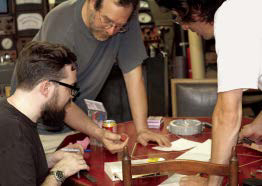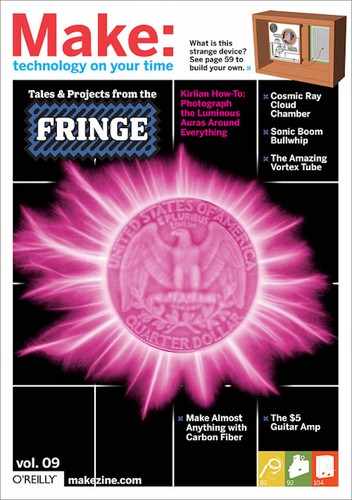P.O.K.E.R. Night
Or, Let’s Build a Vortex Tube Party!

Photography by Mark Frauenfelder and Mister Jalopy
IN 1867, SCOTTISH PHYSICIST ROBERT Clerk Maxwell proposed a “thought experiment,” suggesting that it may be possible to break the second law of thermodynamics, if you could find a molecularly minded demon that was willing to cooperate.
Start with two hypothetical containers of equal temperature with a connecting trap door controlled by a gatekeeper to sort hot from cold molecules. When the demon sees a fast/hot molecule racing toward the door, he opens the trap to let the hotter molecule speed into container A. Similarly, if a slow-moving molecule is headed toward container B, the demon would allow it to pass until the two containers are at different temperatures. Assuming that the demon would have modest demands for his efforts, you would break the cornerstone of physics laws — something for nothing.
The Hilsch Vortex Tube
After an impressive 72-year run, the “Amateur Scientist” column fell victim to a 2001 Scientific American modernization effort. A terrible loss, the “Amateur Scientist” was an inspirational resource that dedicated considerable effort to explaining the hard science behind the projects.
Whether working on “Cloud Chambers to Detect Nuclear Events” (see page 156 for MAKE’s version of the cloud chamber) or “An Inexpensive X-Ray Machine,” you really felt like you were in the midst of serious scientific pursuit and the feeling of exploration was very high — especially with the scant direction.
In November 1958, Scientific American published one of my favorite projects — the Hilsch Vortex Tube. Invented in 1933 by a French physicist named George Ranque, and improved by a German physicist named Rudolf Hilsch in 1955, it uses nothing but compressed air. The design of the device created a vortex that acts as a demon to “split” the hot molecules from the cold by spinning air to very high speeds. How fast? Half a million rpm fast.
Spinning air is enough to generate a temperature change of a couple hundred degrees? Yes, but at the time of the original 1958 article, they weren’t exactly sure how it worked. As a very amateur scientist, I will try to explain the process. Compressed air is shot into a vortex that creates a hollow cyclone of fast, hot air that travels down the interior of the hot pipe. If it were visible, it would look like a tube of hot air that lines the inside of the pipe, and then a smidge of the hot air is exhausted through the almost-closed stopcock.
The remainder of the air is reflected off the nearly blocked stopcock through the center of the hot-air cyclone — in effect, a column of air shooting through the hot-air tube. As this happens, this column of air “gives up” its heat to the surrounding cyclone as it passes through the center. When the cold column reaches the vortex, it shoots through the center and exits the cold side. Whoa.
Cold-Cut-and-Soda-Pop Engineering
Anticipating a lukewarm response from my buddies for a “Let’s Build a Vortex Tube Party,” I invited my amateur scientist friends for a poker night (little did they know that “poker” was an acronym for Proof Of Koncept/Experimentation Revue).
Fearing a rebellion when they discovered there were no poker chips or one-eyed jacks, I made certain to lay out an impressive spread of top-notch cold cuts, provolone, olives, marinated pepperoncinis, and plonk chianti. I would have served a better wine, but I figured these wily characters would have realized they had been duped by my dodgy scheme, checked that their wallets were intact, and hit the door.
Original Mister Jalopy Proposal
With a deep breath and steely resolve, I told the fellas that instead of a freewheeling night of gambling and tasteless jokes, we would be attempting to channel Maxwell’s demon. They went for it — though they insisted on keeping the tasteless jokes. Using segments of iron plumbing pipe as the hot and cold sides, I suggested that we epoxy together a vortex assembly with three ½" slices of a Delrin plastic 3" rod.

Demon illustration by Mark Frauenfelder
MAXWELL’S DEMON THOUGHT EXPERIMENT CIRCA 1867
1. Chambers A and B contain gas at equal temperature. The demon has the door closed but is ready to move quickly to let the molecules through.
2. As a fast/hot molecule approaches from chamber B, the demon throws open the door to admit the molecule to the soon-to-be-hotter chamber A.
3. Much door opening and closing ensues until the demon has tirelessly isolated all the cold from hot molecules.
Revised Approach
The guys are not scientists or machinists but they are talented, creative folks that are deeply interested in how things work. Hoping that would be enough, the group reduced the vortex assembly design to use a single Delrin disk. In my original plan, the washer was replaced with a ½"-thick slice of Delrin, but the revised plan brought back the washer. We didn’t know if the thicker Delrin disk would affect performance, but since we had no idea what we were doing, we decided the fewer changes, the better.
The finished vortex tube looks like a champion! From appearances, it would seem to instantly freeze tissue samples for plague research or, perhaps, cut 1"-thick steel plate with an awesome 1,000-degree cutting flame! Real life offered slightly less spectacular results, but we did measure a temperature spread of 8 degrees between the hot and cold sides. We raised the flag and declared victory!
If I were a real scientist, I would continue to refine the design using our modest success as a starting point, but as an amateur, I am happy with the Proof Of Koncept/Experimentation Revue results. Until an engineer shows up with some imported spicy salami, the vortex tube will sit on the shelf as a memento of a fun late night with good friends.
Mister Jalopy referenced C.L. Stong’s collected columns from the out-of-print The Scientific American Book of Projects for The Amateur Scientist, but the complete, 72-year archive is available on CD-ROM (Scientific American’s The Amateur Scientist, Science Fair Edition, $30, brightscience.com).
AiRTX International (airtxinternational.com) sells commercial vortex tubes capable of generating temperatures from -40°F to 250°F. We thank them for allowing us to use their superb illustration.

Despite being hoodwinked, my friends met the vortex tube challenge with enthusiasm and a determination to succeed, provided the beer did not run out.

In the original “Amateur Scientist” design, adjustments are made via the stopcock on the hot side and the interchangeable washer on the cold. (Source: The Scientific American Book of Projects for The Amateur Scientist, C.L. Stong, 1960)

AiRTX International’s commercial vortex tube ($109-$149) produces frigid air from room-temperature compressed air.
Mister Jalopy is an earnest but amateur scientist. Know more about vortex tubes than he does? We wouldn’t be surprised. Join us for vortex discussions at makezine.com/09/vortex_tube, as we have lots of questions.
THE P.O.K.E.R. TUBE, VERSION 1

VERSION 2
In just a few hours, we managed to cobble together a proof-of-concept Hilsch vortex tube that produced two streams of air with small, but measurably different temperatures. You’re welcome to try to improve on our efforts. If you succeed (or even if you fail) let us know at makezine.com/09/vortex_tube.
Illustration by Gerry Arrington

Cutting the Delrin disk with a Dremel jigsaw.

The actual vortex chamber is very small, as seen here.

The glue only held for seconds; epoxy putty was much stronger.

Our Hilsch tube is not as pretty as SciAm’s, but it worked (sort of).
